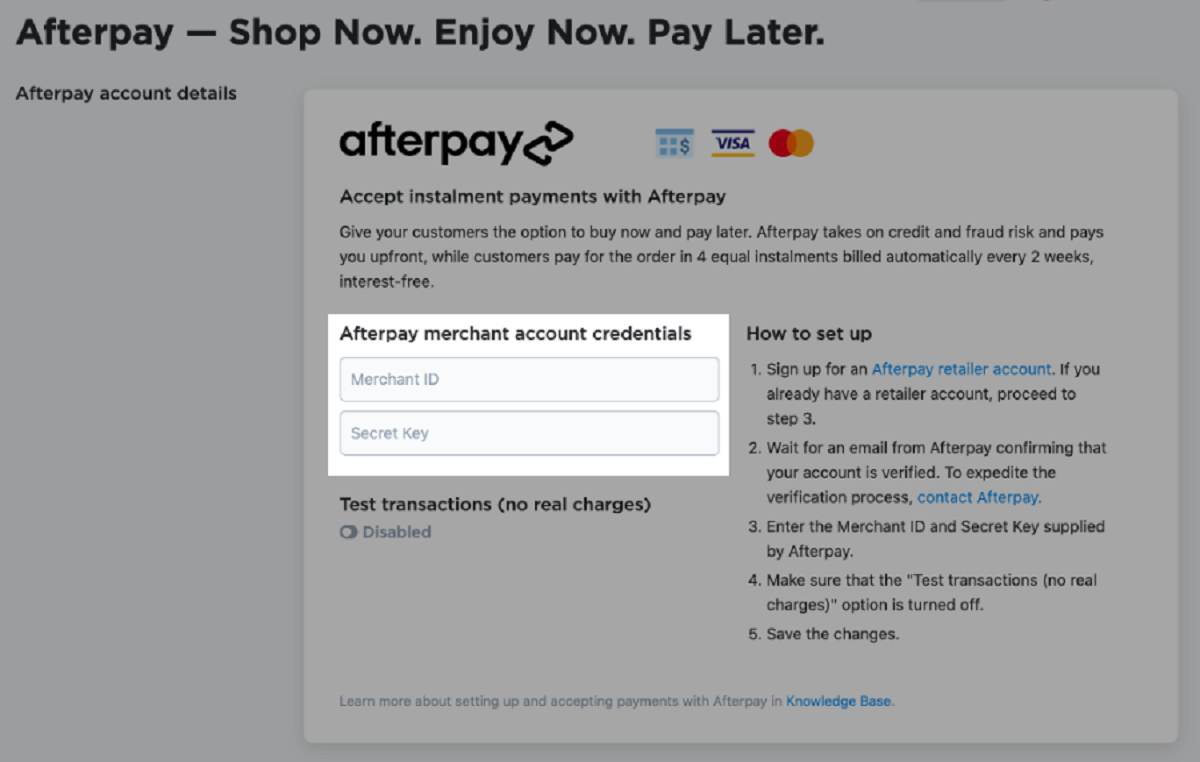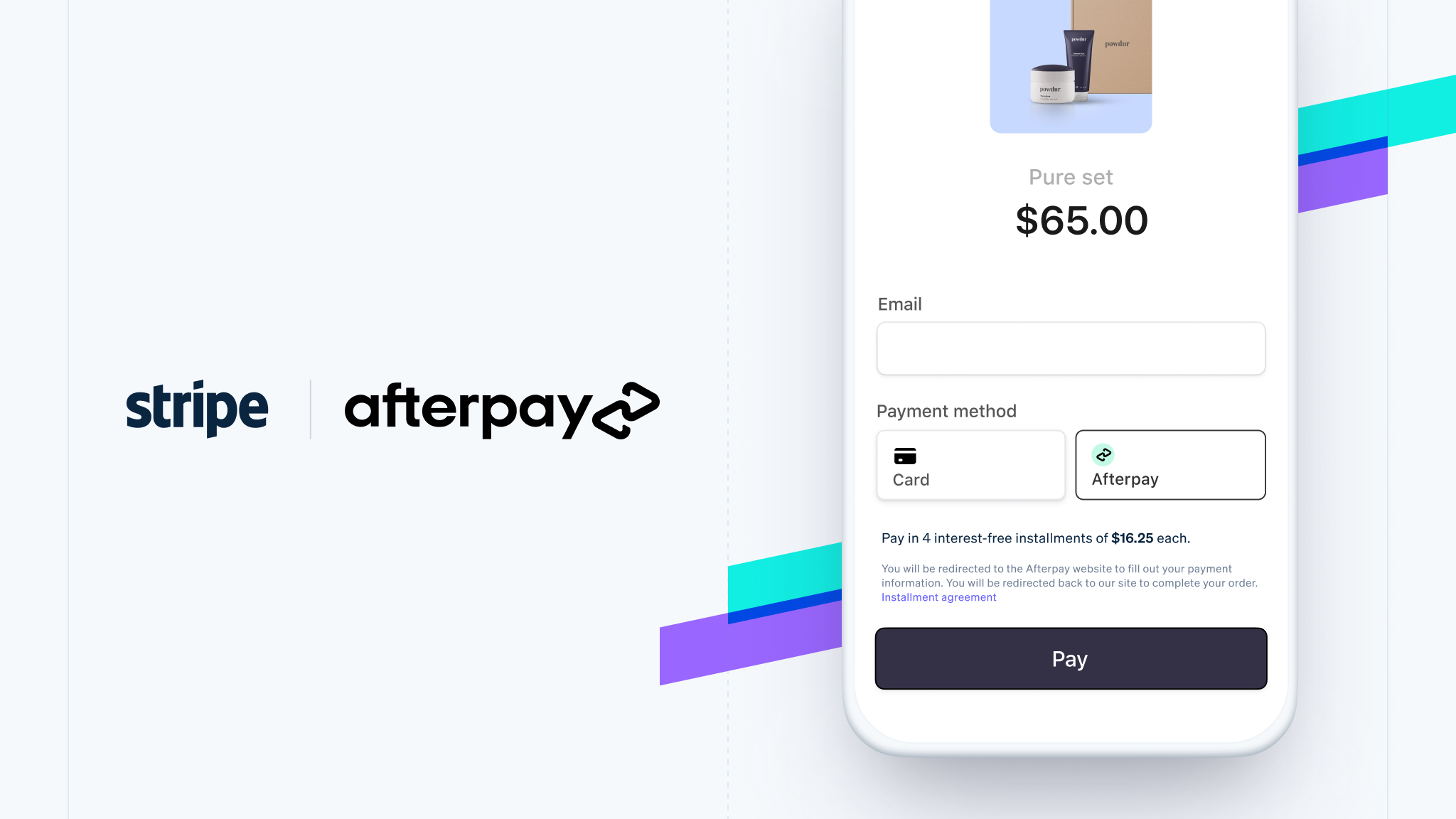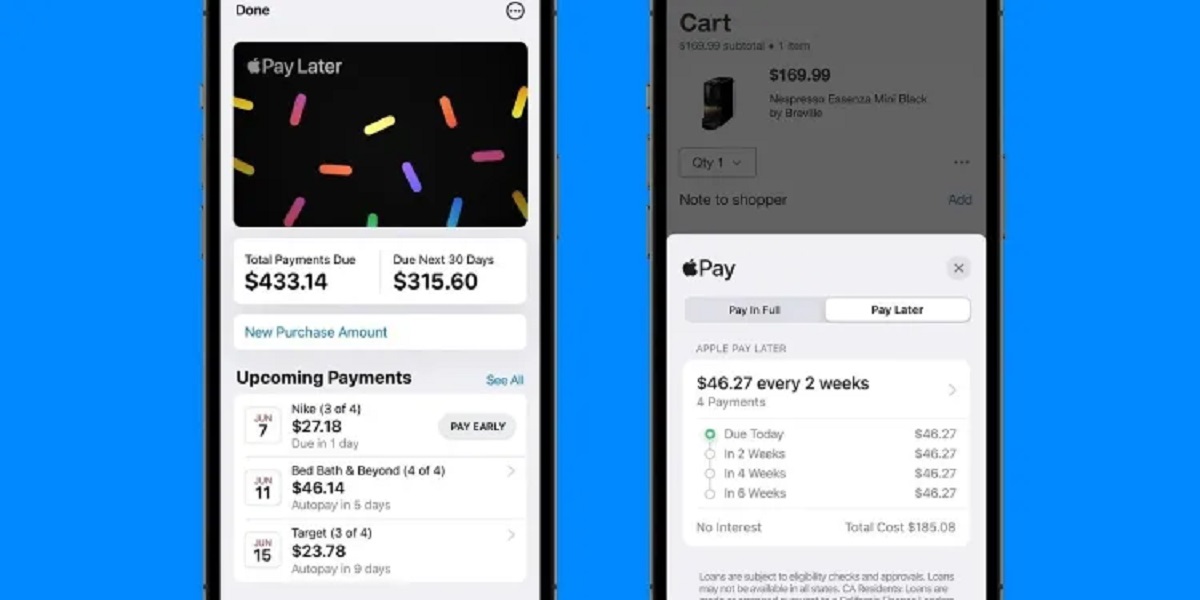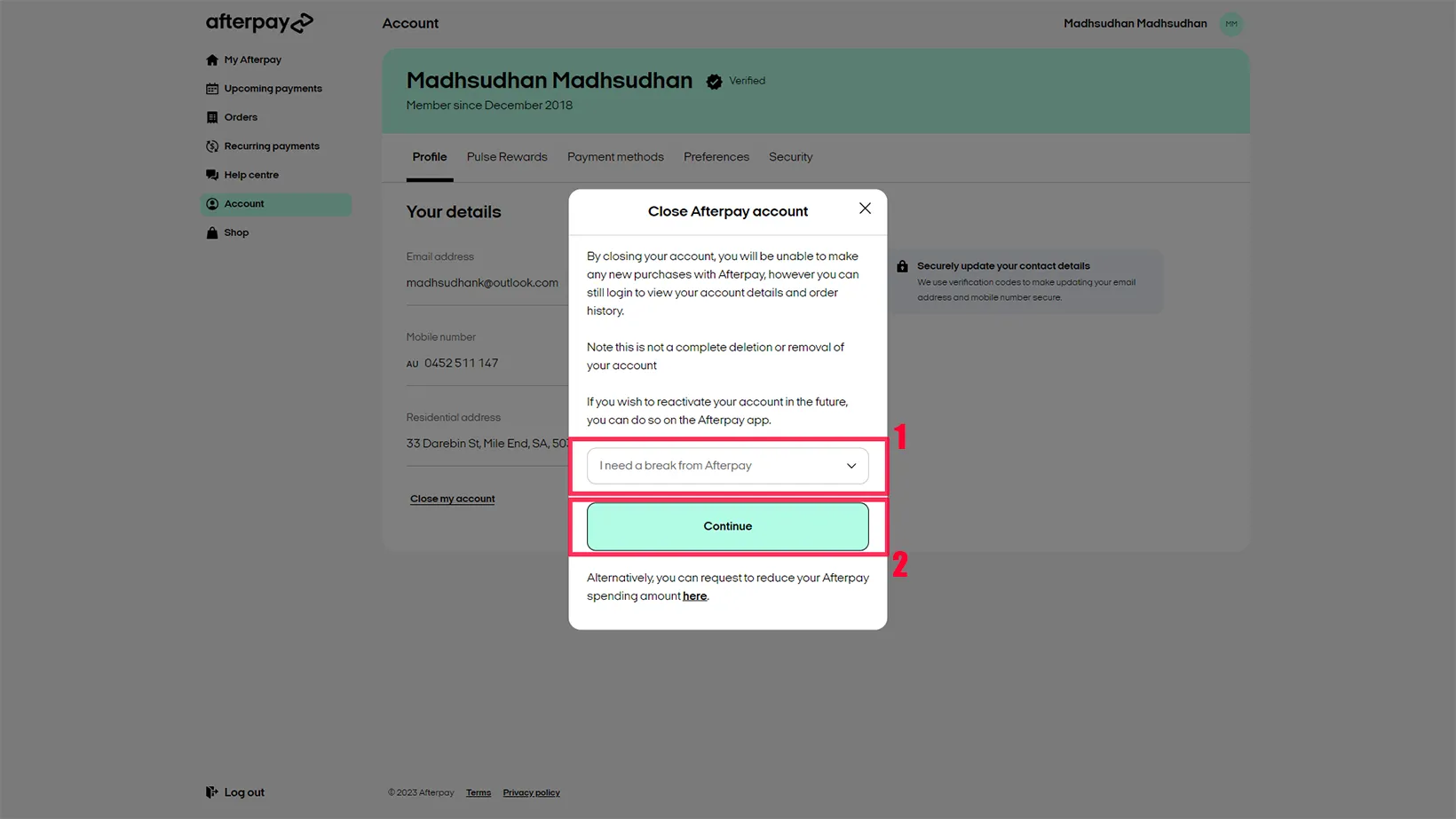What is Afterpay?
Afterpay is a popular buy now, pay later service that allows customers to make purchases and pay for them in installments, without having to take out a traditional loan or pay any interest. It is a versatile payment option that can greatly enhance the shopping experience and boost sales for online businesses.
With Afterpay, customers can instantly split the cost of their purchase into four equal, interest-free payments made every two weeks. This allows them to spread out their expenses and make budget-friendly purchases. The payments are automatically deducted from the customer’s nominated debit or credit card, making the process seamless and hassle-free.
One of the key benefits of Afterpay is the simplicity and convenience it offers to both customers and merchants. Customers can easily set up an Afterpay account and start using it for their online purchases within minutes. Merchants can seamlessly integrate Afterpay into their online stores, providing a seamless checkout experience for their customers.
Afterpay also provides valuable benefits to businesses. By offering this payment option, merchants can attract a wider customer base and increase conversion rates. Many customers are attracted to the flexibility and affordability of Afterpay, which can ultimately boost sales and revenue for the business.
Furthermore, Afterpay reduces the risk of transaction disputes and chargebacks for merchants. Since Afterpay handles the payment process, merchants are guaranteed full payment for the purchase, even if the customer defaults on their payments. This provides a layer of security and peace of mind for businesses.
In summary, Afterpay is a convenient and flexible buy now, pay later service that allows customers to make purchases and spread out their payments. It is a valuable payment option for businesses, as it can attract more customers, increase conversion rates, and reduce the risk of transaction disputes. By offering Afterpay, businesses can enhance the shopping experience and drive financial success.
How does Afterpay work?
Afterpay is a simple and straightforward payment method that allows customers to make purchases and split the cost into four equal payments, without any interest fees. Here’s a step-by-step breakdown of how Afterpay works:
- Sign up for an Afterpay account: Customers can easily create an Afterpay account by providing some basic information, such as their email address, phone number, and payment details.
- Choose Afterpay at checkout: When making a purchase online, customers can select Afterpay as their payment method during the checkout process. Afterpay is available on thousands of websites across various industries.
- Pay the first installment upfront: After selecting Afterpay, customers will be required to make their first installment payment upfront. This payment is typically around 25% of the total purchase price.
- Receive the items: Once the first payment is made, customers will receive their items or services as usual. There are no delays or disruptions in the delivery process.
- Pay the remaining installments: Over the next six weeks, customers will automatically be charged the remaining three installments, each two weeks apart. These payments will continue until the full amount is paid off.
- Manage payments: Customers can easily manage their Afterpay payments through the Afterpay mobile app or website. They can view upcoming payments, update payment methods, and even pay off the remaining balance early.
It’s important to note that Afterpay does perform a soft credit check to assess the customer’s ability to repay the installments. However, this check does not typically impact the customer’s credit score.
Afterpay also provides a transparent payment schedule, so customers know exactly when each installment will be due. Additionally, Afterpay offers reminders and notifications to ensure customers are aware of upcoming payments and any associated fees.
In summary, Afterpay simplifies the payment process by allowing customers to make purchases and split the cost into four equal installments. It offers convenience, transparency, and flexibility for both customers and merchants. With Afterpay, customers can enjoy their purchases immediately while spreading out their payments, making it an attractive payment solution for many
Setting up an Afterpay account
The process of setting up an Afterpay account is quick and straightforward, allowing customers to start using the service in no time. Here are the steps to set up an Afterpay account:
- Visit the Afterpay website or app: Customers can access the Afterpay website or download the mobile app from their respective app stores.
- Create an account: Click on the “Sign Up” or “Join Now” button to start creating an Afterpay account. Customers will be asked to provide their personal information, including their name, email address, and phone number.
- Verify your identity: After entering the required information, customers may need to verify their identity. This can be done by providing additional details or documentation, such as a driver’s license or proof of address.
- Add a payment method: To complete the account setup process, customers need to add a payment method to their Afterpay account. They can link their debit or credit card details securely.
- Review and agree to the terms: Before finalizing the setup, customers should carefully review Afterpay’s terms and conditions, as well as their privacy policy. It’s important to understand the obligations and responsibilities associated with using the service.
- Start using Afterpay: Once the account setup is complete, customers can start using Afterpay to make purchases from participating online retailers. Afterpay is widely accepted across various industries and popular eCommerce platforms.
It’s worth mentioning that Afterpay may perform a soft credit check as part of the account setup process. This helps determine the customer’s ability to repay the installments but does not typically impact their credit score.
After setting up an Afterpay account, customers can easily manage their payments, view upcoming installment schedules, and make changes to their account settings through the Afterpay website or app. It’s essential to keep track of the payment dates and ensure sufficient funds are available to avoid any late fees or penalties.
In summary, setting up an Afterpay account is a simple and user-friendly process. By following a few steps, customers can create an account, link their payment method, and start enjoying the flexibility and convenience of the Afterpay service.
Linking Afterpay to your online store
Integrating Afterpay into your online store is a seamless process that can help enhance the shopping experience for your customers and boost your sales. Here’s a step-by-step guide on how to link Afterpay to your online store:
- Check compatibility: Before getting started, ensure that your eCommerce platform is compatible with Afterpay. Afterpay is compatible with many popular platforms, such as Shopify, WooCommerce, Magento, and BigCommerce.
- Create an Afterpay account: If you haven’t already, sign up for an Afterpay account as a merchant. You can do this on the Afterpay website by providing the necessary business information.
- Install the Afterpay plugin or app: Choose the appropriate Afterpay plugin or app for your eCommerce platform. Install it on your website following the provided instructions. This plugin or app will enable Afterpay as a payment option on your store.
- Configure the settings: Once the plugin or app is installed, configure the settings to match your business needs. Customize the appearance of the Afterpay payment option to align with your store’s branding.
- Test the integration: Before going live, it’s crucial to test the integration to ensure that everything is functioning correctly. Place a test order on your website using the Afterpay payment option to confirm that the transaction goes through smoothly.
- Communicate with your customers: Once the Afterpay integration is live on your online store, make sure to inform your customers about this payment option. Highlight its benefits, such as the ability to split payments and enjoy interest-free installments.
By linking Afterpay to your online store, you provide your customers with a convenient and flexible payment method that can boost their purchasing confidence. Afterpay has become increasingly popular among shoppers, and offering it as a payment option can attract new customers and increase conversion rates.
Furthermore, Afterpay offers robust security features and fraud protection measures, giving you peace of mind when processing transactions. Merchants are guaranteed full payment for the purchase, even if the customer defaults on their payments.
Lastly, stay up to date with the latest Afterpay features, enhancements, and promotions to make the most of this payment solution. Afterpay often provides marketing materials and resources that can help you promote the service to your customers and drive more sales.
In summary, integrating Afterpay into your online store is a straightforward process that can enhance the shopping experience for your customers. By offering Afterpay as a payment option, you can attract more customers, increase conversion rates, and provide a secure payment solution for your eCommerce business.
Setting up Afterpay payment options in your store
Setting up Afterpay payment options in your store is a crucial step to ensure a seamless checkout process for your customers. Follow these steps to integrate Afterpay payment options into your online store:
- Access your eCommerce platform: Log in to your eCommerce platform’s admin panel to access the settings and configuration options for your store.
- Locate the payment options: Navigate to the payment options or payment gateway settings within your platform. This is where you can add or configure payment methods for your store.
- Enable Afterpay: If Afterpay is available as a built-in payment option, simply enable it by selecting the appropriate checkbox or toggle. If not, you may need to install an Afterpay plugin or extension provided by Afterpay or a third-party developer.
- Configure Afterpay settings: Once Afterpay is enabled, you will have access to configure various settings. Customize the appearance of the Afterpay payment option to match your store’s branding, adjust the messaging and language, and set any specific terms or restrictions.
- Connect your Afterpay account: You’ll be prompted to connect your Afterpay account to your store. Follow the instructions to securely link your Afterpay merchant account to your eCommerce platform.
- Test the functionality: It’s crucial to test the Afterpay payment option to ensure it is integrated correctly. Place a test order and complete the checkout process using Afterpay to verify that the transactions are processed successfully.
Keep in mind that the specific steps may vary depending on your chosen eCommerce platform and the Afterpay integration method. However, most platforms and Afterpay plugins offer user-friendly interfaces and documentation to guide you through the setup process.
Once Afterpay payment options are set up in your store, be sure to prominently display the Afterpay logo and messaging on your website, especially on product pages and the shopping cart. This will inform your customers that they can choose Afterpay as a payment option at checkout.
Regularly monitor your transaction history and payment settlements in your Afterpay merchant account to ensure smooth processing and track your revenue. Familiarize yourself with any fees and charges associated with using Afterpay, and ensure they align with your business goals and profitability.
In summary, setting up Afterpay payment options in your online store requires a few simple steps within your eCommerce platform’s settings. By enabling Afterpay, customizing the appearance, and testing the functionality, you can provide a seamless and flexible payment option for your customers.
Testing Afterpay functionality
Testing the Afterpay functionality before launching it on your online store is crucial to ensure a smooth and error-free checkout process for your customers. By following these steps, you can thoroughly test the Afterpay integration:
- Create a test environment: Set up a test environment or sandbox that mimics your live online store. This allows you to conduct tests without affecting your actual customer orders or transactions.
- Place a test order: Add a product to the cart and proceed to the checkout using Afterpay as the payment method. Verify that the Afterpay payment option is available and selectable by customers.
- Complete the transaction: Walk through the entire purchase process, including entering customer information, billing details, and confirming the order. Ensure that the order confirmation page displays the Afterpay payment details correctly.
- Verify payment processing: Check that the Afterpay installment breakdown is accurate for the test order. Ensure that the transaction is recorded correctly in your Afterpay merchant account, including the purchase amount and scheduled payment dates.
- Simulate different scenarios: Test various scenarios, such as canceling an order with Afterpay selected, applying discounts or promotional codes, and updating customer details during the checkout process. This helps identify any potential issues and ensures smooth functionality in different situations.
- Test refund and return processes: If your store accepts returns or offers refunds, test the process with Afterpay transactions. Verify that the refund or return is properly communicated and processed in both your online store and Afterpay.
- Test customer notifications: Check if your customers receive accurate and timely notifications regarding their Afterpay payments, such as payment due reminders or order confirmation emails. Ensure that the content and timing of these notifications align with your business needs.
It’s essential to repeat the testing process whenever you make any changes to your online store or updates to the Afterpay integration. This helps maintain a glitch-free shopping experience for your customers.
If you encounter any issues or inconsistencies during testing, reach out to Afterpay’s technical support or consult the documentation provided by Afterpay or your eCommerce platform’s support team. They can assist you in resolving any concerns and ensuring that the Afterpay functionality works seamlessly on your store.
In summary, thorough testing of Afterpay functionality is crucial to verify that the integration works smoothly and accurately on your online store. By replicating different scenarios and verifying payment processing, you can provide a hassle-free buying experience for your customers.
Tips for maximizing Afterpay sales
Afterpay is not only a convenient payment option for customers but also offers opportunities for merchants to boost their sales and increase customer satisfaction. Here are some tips to maximize your Afterpay sales:
- Promote Afterpay prominently: Clearly display the Afterpay logo and messaging on your website, especially on product pages and during the checkout process. This helps customers identify Afterpay as a payment option and encourages them to make a purchase.
- Highlight the benefits: Educate your customers about the benefits of using Afterpay, such as the ability to split payments into manageable installments without paying interest. Emphasize the convenience and affordability aspects to attract more customers.
- Include Afterpay in marketing campaigns: Incorporate Afterpay into your marketing efforts, such as through email campaigns, social media posts, or banner advertisements. Highlight the availability of Afterpay to encourage potential customers to make a purchase.
- Offer Afterpay across all price ranges: Don’t limit the use of Afterpay to high-priced items only. Make it available for a wide range of products to capture a broader audience and increase the likelihood of more purchases.
- Emphasize limited-time promotions: Create exclusive deals or limited-time promotions specifically for customers who use Afterpay. This can incentivize customers to make a purchase sooner and increase sales volume.
- Optimize product descriptions and photos: Present your products in the most appealing way possible by using high-quality product images and writing compelling descriptions. Highlight the value and benefits of your products to increase their perceived value.
- Offer free shipping: Consider providing free shipping for orders made using Afterpay. This can provide an extra incentive for customers to choose Afterpay as their payment option and increase both sales and customer satisfaction.
- Optimize the checkout process: Ensure a smooth and user-friendly checkout process, with clear instructions on how to select Afterpay as the payment option. Minimize the number of steps required, reduce distractions, and provide a seamless experience for your customers.
- Monitor Afterpay analytics: Regularly review your Afterpay analytics to gain insights into how customers are using the payment option, the average order value, and the conversion rate. Use this data to make data-driven decisions and fine-tune your marketing strategy.
- Provide excellent customer service: Offer exceptional customer support to resolve any questions or concerns related to Afterpay. Promptly respond to customer inquiries and provide clear and accurate information to build trust and encourage repeat purchases.
By implementing these tips, you can optimize your use of Afterpay and maximize your sales potential. Building customer awareness, utilizing effective marketing strategies, and providing a seamless buying experience will contribute to the success of your Afterpay sales initiatives.
Afterpay fees and charges
Understanding the fees and charges associated with Afterpay is essential to accurately communicate costs to your customers and manage your financials effectively. Here’s an overview of the fees and charges typically involved with Afterpay:
- Merchant service fees: As a merchant, you may incur certain fees for using Afterpay. These fees are typically a percentage of the transaction value and may vary based on factors such as your industry and sales volume. It’s essential to review the merchant service agreement provided by Afterpay or consult with their support team for a clear understanding of the fees applicable to your business.
- Late fees: Afterpay charges late fees if a customer misses a scheduled installment payment. These fees are outlined in the terms and conditions agreed upon by the customer at the time of setting up their Afterpay account. Late fees are set by Afterpay and may vary based on the purchase price and the country in which the transaction takes place. Ensure that your customers are aware of these potential fees to minimize misunderstandings or dissatisfaction.
- Returned payment fees: If a customer’s payment fails or is returned, Afterpay may charge a fee. This fee covers any costs incurred by Afterpay due to the failed payment, such as bank fees. Communicate this to your customers to encourage responsible and timely payment behavior.
It’s important to note that Afterpay does not charge interest or any upfront fees to customers. However, customers are required to make their installment payments on time to avoid late fees.
Managing and tracking Afterpay fees and charges can be done through your Afterpay merchant account. Ensure that you stay up to date with any changes in fee structures or additional charges by regularly reviewing the information provided by Afterpay.
It is recommended that you clearly communicate the fees and charges associated with Afterpay to your customers. This can be done by displaying the relevant information on your website, including the payment terms and conditions during the checkout process, and providing a link to Afterpay’s website for detailed information.
By transparently presenting the fees and charges, you can build trust with your customers and avoid any potential disputes or misunderstandings regarding payments.
In summary, familiarizing yourself with the fees and charges associated with Afterpay is crucial for both merchants and customers. By clearly communicating this information and ensuring accurate financial management, you can provide a transparent and positive experience for your customers.
Afterpay customer service
Providing excellent customer service is essential for a positive Afterpay experience. Afterpay offers dedicated support channels to assist both customers and merchants with any inquiries, concerns, or issues that may arise. Here are the key aspects of Afterpay customer service:
- Customer support: Afterpay provides customer support services to assist customers with any questions or difficulties they may encounter. Customers can reach out to Afterpay’s support team through various channels, such as phone, email, or live chat. It’s important to ensure that your customers are aware of these support options and how to access them.
- Merchant support: Afterpay understands the importance of supporting merchants in providing a seamless payment experience. As a merchant, you can access dedicated support channels to address any technical, operational, or account-related queries. Consult Afterpay’s merchant support resources or reach out to their support team to get the assistance you need.
- Online resources: Afterpay offers a range of online resources, including comprehensive FAQs, guides, and documentation. These resources can help both customers and merchants find answers to common questions or navigate through certain processes. Encourage your customers to explore these resources before reaching out to customer support for basic inquiries.
- Clear communication: Afterpay prioritizes clear and transparent communication with both customers and merchants. They strive to provide accurate and up-to-date information regarding payments, fees, refund processes, and any changes or updates to their services. Regularly review the communications from Afterpay to ensure that you are aware of any important updates or announcements.
- Timely response: Afterpay aims to provide prompt responses to customer inquiries and merchant support tickets. However, response times may vary based on the volume of inquiries received. Encourage your customers to be patient while waiting for a response and assure them that their concerns will be addressed as soon as possible.
When communicating with Afterpay’s customer service or merchant support teams, be prepared to provide necessary information such as transaction details, order numbers, or account information. This will help expedite the process of resolving any issues or inquiries.
It’s also beneficial to keep a record of communication with Afterpay, whether it’s through email, chat transcripts, or ticket numbers. This can be helpful for reference purposes or in case any disputes arise that require evidence of communication.
In summary, Afterpay offers accessible customer service and merchant support channels to address inquiries and concerns. Clear communication, timely responses, and utilizing online resources can help ensure a positive customer experience and efficient issue resolution.
Frequently Asked Questions about setting up Afterpay
Setting up Afterpay can involve various processes and considerations. Here are answers to some commonly asked questions about setting up Afterpay for your online business:
Q: Is Afterpay available for all types of businesses?
A: Afterpay is available for a wide range of businesses, including online retailers across various industries. However, eligibility requirements may vary based on your location and the specific terms and conditions set by Afterpay. It’s recommended to review Afterpay’s guidelines or reach out to their support team to confirm your eligibility.
Q: How long does it take to set up an Afterpay account?
A: Setting up an Afterpay account typically takes just a few minutes. You’ll need to provide some basic information about your business, such as your email address, phone number, and payment details. After registering, you may need to verify your identity, but this process is usually quick and straightforward.
Q: Can I use Afterpay with my existing eCommerce platform?
A: Afterpay is compatible with many popular eCommerce platforms, including Shopify, WooCommerce, Magento, and BigCommerce. You can leverage Afterpay plugins or extensions specifically designed for your platform to integrate Afterpay seamlessly into your online store.
Q: Are there any fees for using Afterpay?
A: As a merchant, you may incur certain fees associated with using Afterpay. These fees can vary and are typically a percentage of the transaction value. It’s important to review the merchant service agreement provided by Afterpay or consult with their support team to understand the fees specific to your business.
Q: Do I need a credit check to use Afterpay?
A: Afterpay typically performs a soft credit check when customers create an account. This check helps assess the customer’s ability to make the installment payments. However, this credit check does not usually impact the customer’s credit score.
Q: Can I customize the appearance of the Afterpay payment option in my store?
A: Yes, you can usually customize the appearance of the Afterpay payment option to align with your store’s branding. Afterpay plugins or integrations will often allow you to modify the look and feel of the payment option to ensure consistency with your website’s design.
Q: How can I test the Afterpay functionality in my store?
A: To test the Afterpay functionality, you can create a test environment or sandbox that closely resembles your live online store. Place a test order using Afterpay as the payment option and verify that the transaction processes correctly. This allows you to confirm that the integration is working as expected before making it available to your customers.
Q: Is customer support available for Afterpay users?
A: Yes, Afterpay provides customer support services to assist both customers and merchants with any inquiries or issues. Customers can reach out to Afterpay’s support team through various channels such as phone, email, or live chat. Merchants can access dedicated support channels to address any technical or account-related queries.
Q: Can I refund or cancel an order made with Afterpay?
A: Yes, you can refund or cancel an order made with Afterpay. The process for refunding orders follows your standard refund procedures. Afterpay will adjust the remaining payment schedule accordingly and provide the customer with a refund of any amounts paid.
It’s important to note that answers to these questions may vary based on the specific terms and conditions set by Afterpay and your location. Refer to Afterpay’s official documentation, support resources, or consult their support team for the most accurate and up-to-date information regarding setting up Afterpay for your business.

























